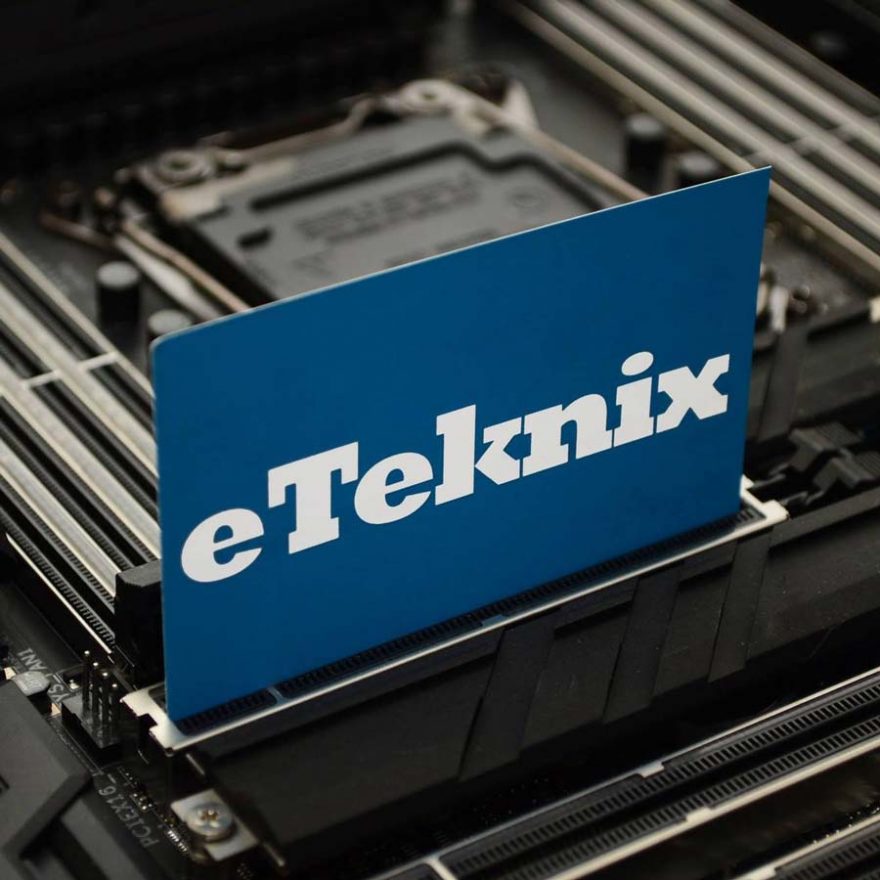be quiet! Pure Power 10 600W Power Supply Review
Peter Donnell / 8 years ago
Introduction & Packaging
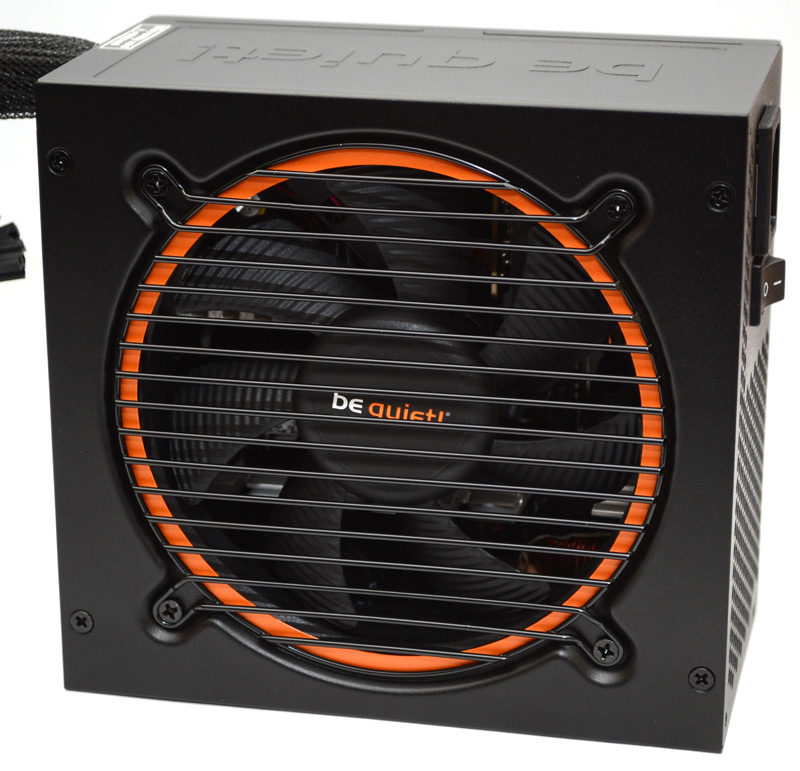
be quiet! is one of the biggest names in the business when it comes to making high-performance PC hardware, with their PSUs often ranking as some of the best around. Of course, their high-end products often come with a premium price tag to match, but today we see the release of their new Pure Power 10 PSU, which promises to be exceptionally quiet, reliable and offer great value for money.
When it comes to building a PC, you never want to skimp on the quality of your power supply. The latest from be quiet! aims to deliver 600W of power, which is more than enough for most mid-to-high-end gaming systems, especially with newer and more efficient GPUs. Not only that, but it’ll deliver 80 Plus Silver efficiency, semi-modular cable management for a neat and tidy build, and as the brand name suggests, it’s “be quiet!” too. Finally, it’s backed up by a 3-year warranty, giving you added peace of mind.
Packaging and Accessories
The box is nicely designed, as they always are from be quiet! with a nice image of the PSU on the front, and a few details about the spec. You’ll also see that it’s tagged “essential” which is the moniker be quiet! give to their more affordable product ranges.
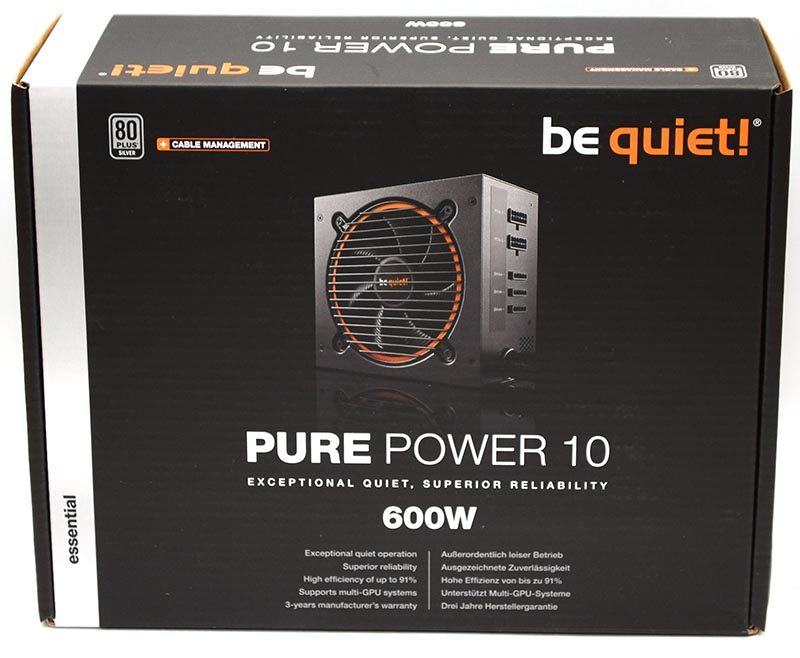
Around the back, all the technical information you could ever need, such as load capabilities, and information for the lengths of all the included cables.
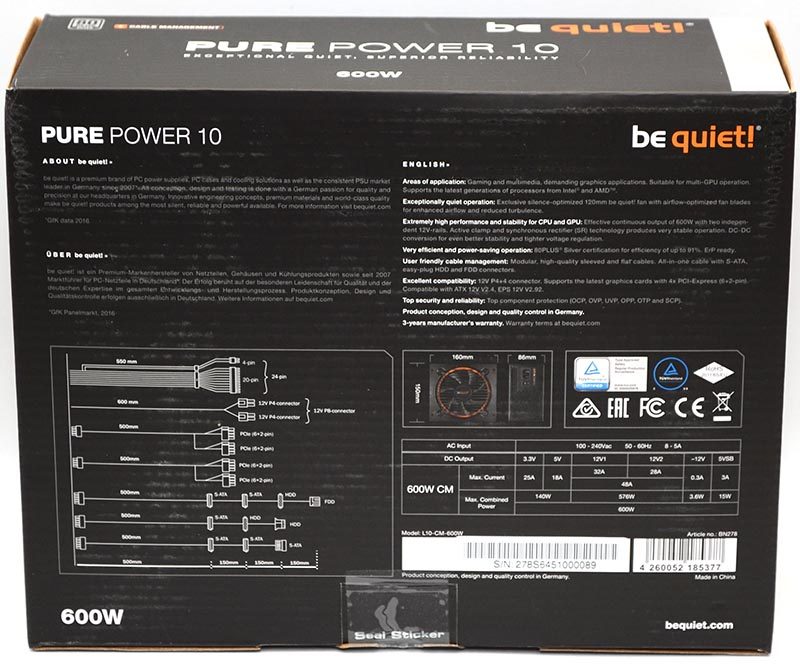
In the box, you’ll find the mains power cable, user manual, fitting screws, and a few cable ties to help you keep things neat and tidy.
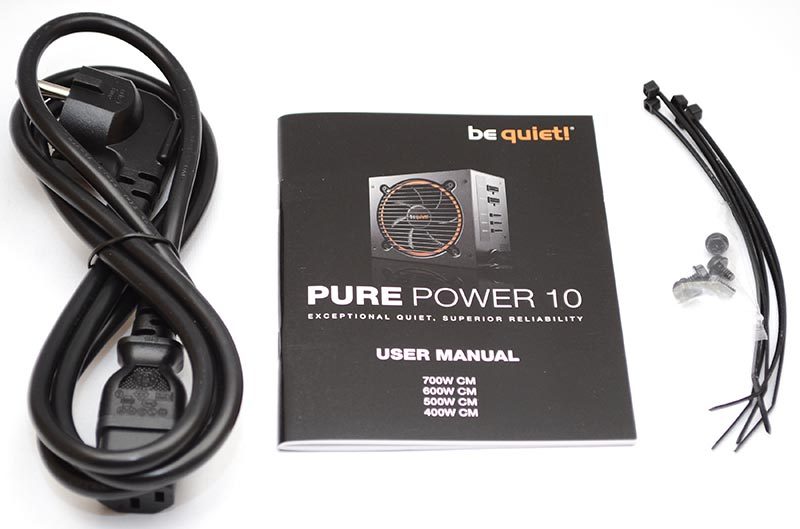
There’s also a collection of additional modular cables, all of which come with a flat cable design. There are two GPU cables, each with dual 6+2 headers.
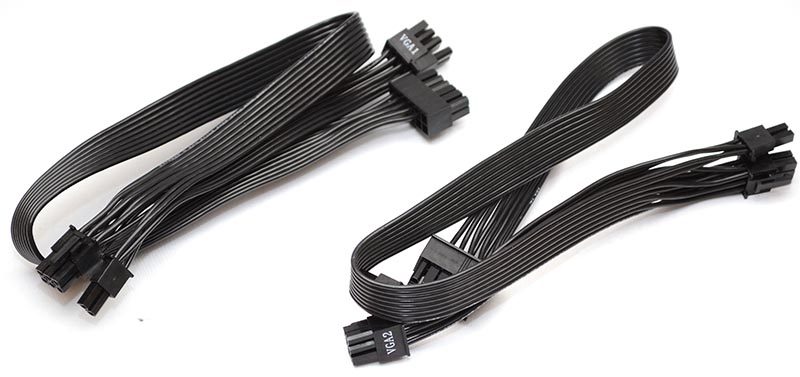
Three more cables deal with all your peripherals, with a Molex cable, SATA cable, and a mixed SATA/Molex cable included in the box.
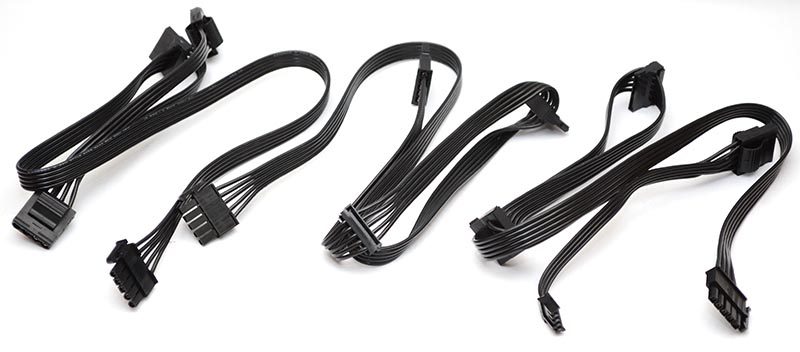
A Closer Look – Exterior
First impressions are always important, and the Pure Power 10 makes a strong one. The build quality looks great and feels great too, with a matte black finish and nicely finished edges that give it a premium quality vibe.
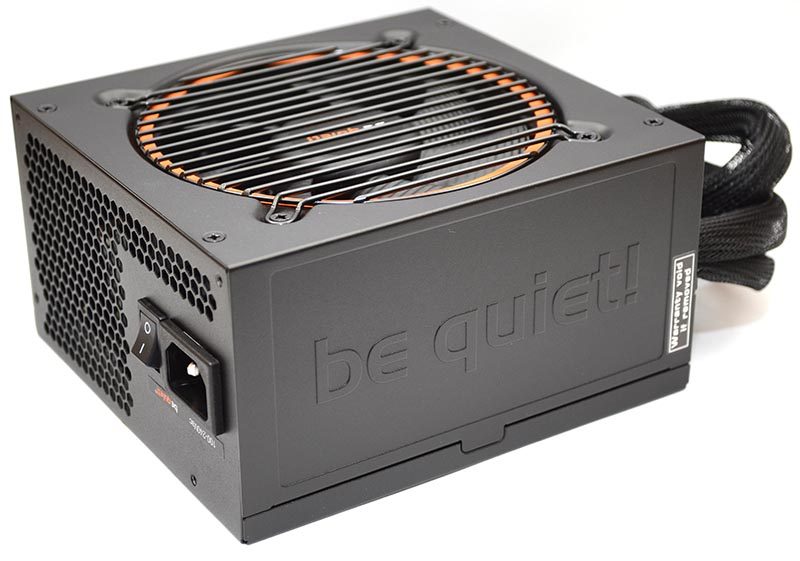
Around the back, you’ll find plenty of ventilation for keeping the PSU nice and cool, as well as the AC line-in socket, and a master power switch for when you want your system 100% powered down.
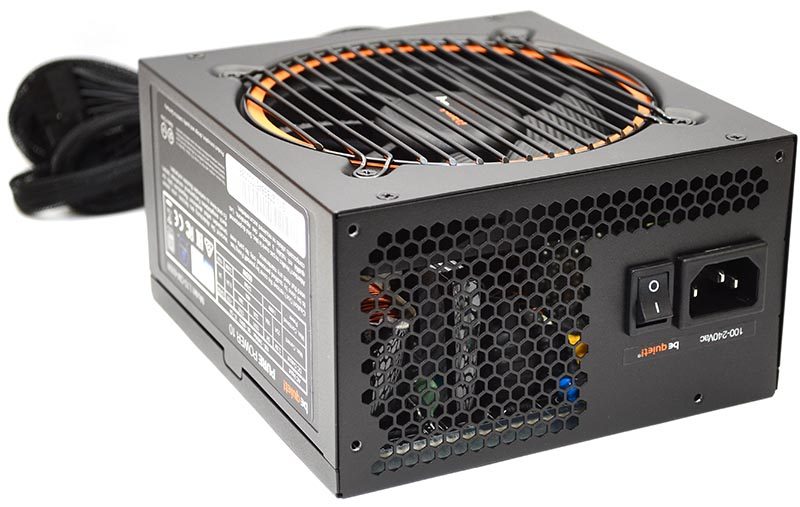
On the side, all the safety and power information is clearly detailed. Here we can see there are two 12V rails, with up to 32A on 12V1, 28A on 12V2 or a combined load of 48A, which is more than anyone would ever need on a 600W PSU, so no issues there.
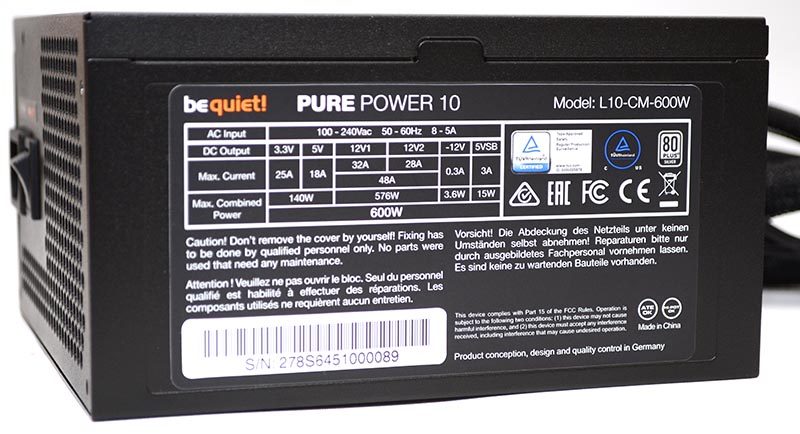
The top cover is just a blank panel but otherwise looks neat and tidy.
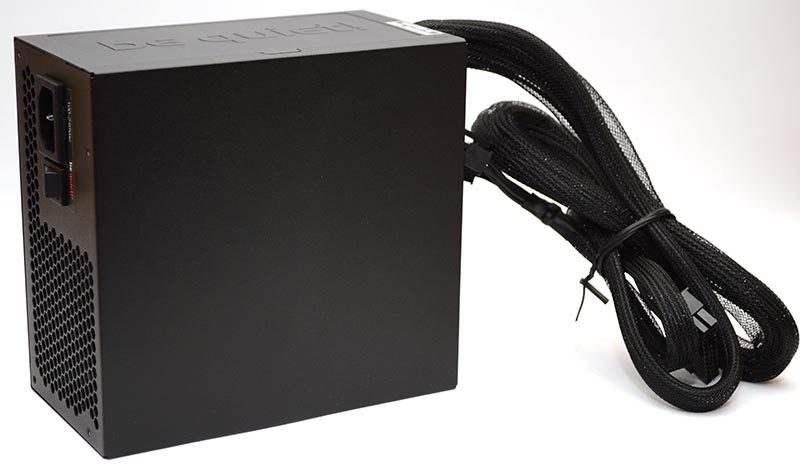
This is the best looking bit for sure, with a high-quality metal fan guard over that be quiet! fan, with a lovely deep orange trim around the edge to give it some added flair. This may be a more affordable PSU, but it certainly doesn’t look anything less than premium.

Around the back, you’ll find five modular sockets, two for the PCIe cables, and three for the peripherals; nothing too complex, but all you’ll need for most system builds.
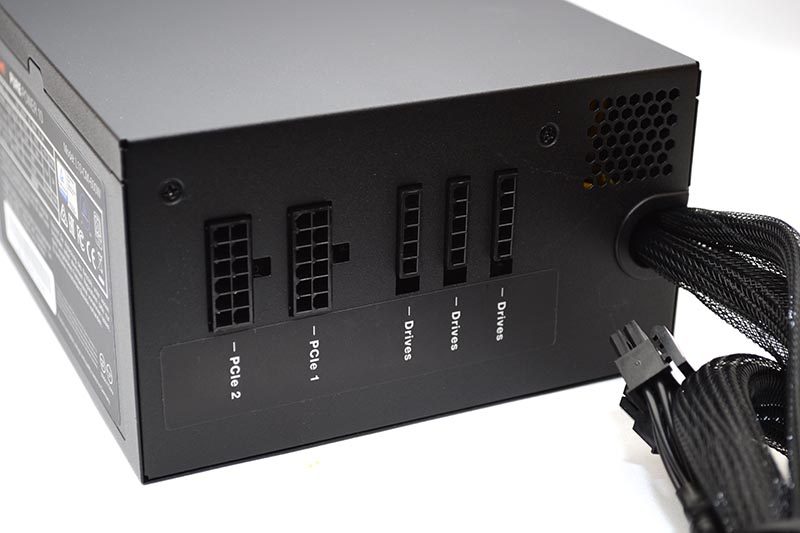
Of course, this is a semi-modular unit, and you’ll find the 24-pin and the 4+4-pin cables are hard-wired. Personally, I think this is a good way of doing things, as every system will need these two cables.
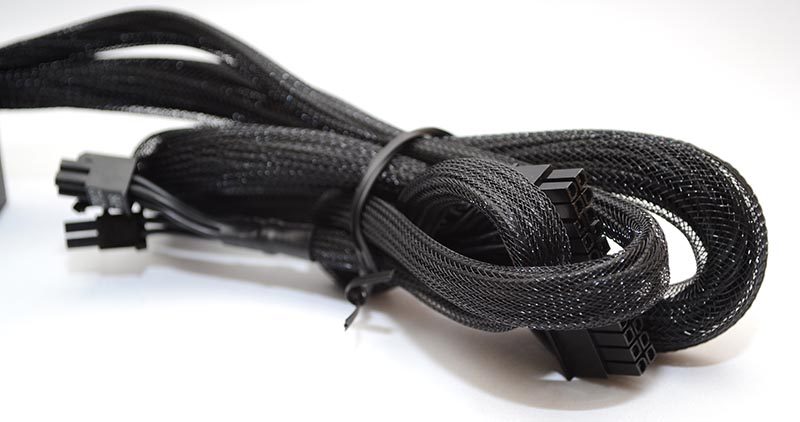
A Closer Look – Interior
be quiet! are experts at what they do, so we wouldn’t expect anything less than a well-designed interior, and we’re right not to, it looks pretty neat and tidy in there!
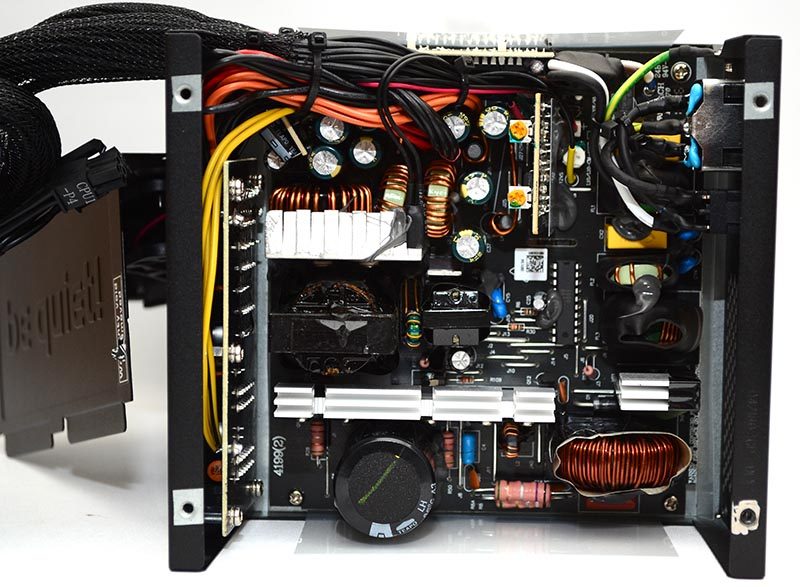
This is only a 600W unit, so it’s unlikely to draw too much heat, which should mean it’ll run quietly in general, but there’s lots of room in here for airflow, and a few aluminium heat sinks on major components too.
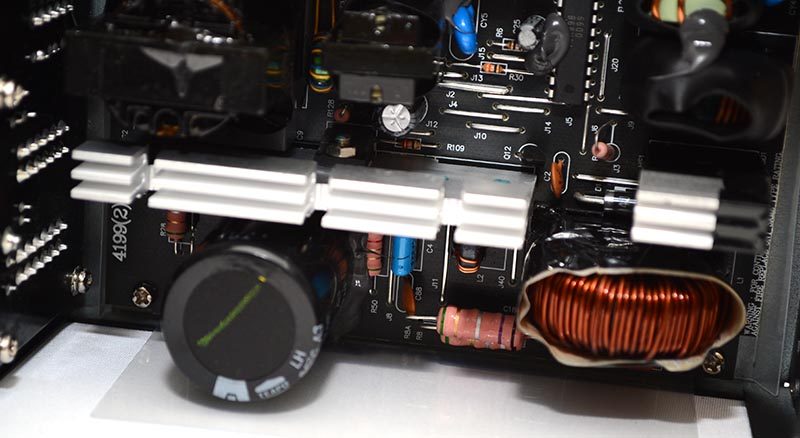
The AC line-in and EMI filtering stage looks to be one of the cleanest I’ve seen. All cable ends are wrapped and shielded, and that can only be a good thing. Hopefully, this will lead to even less ripple in the power delivery.
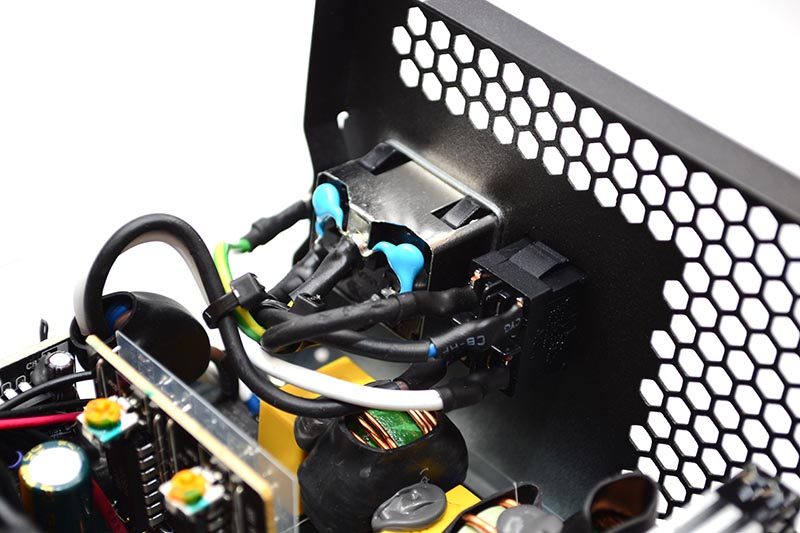
Being a small wattage unit, there’s no need for massive hardware here, but there are a few smaller daughter boards in here too, which will help deal with PFC, and a few safety features.
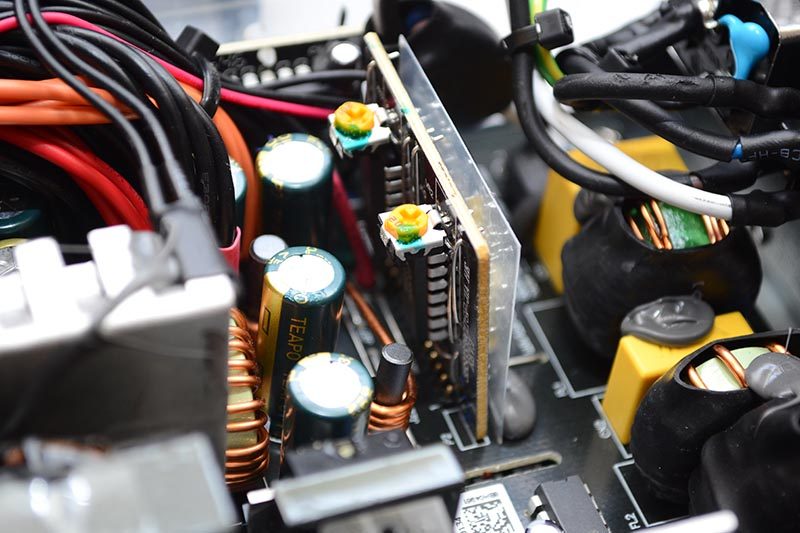
The main bulk capacitor is a Teapo unit, rated at 85c, 420V, and 330 uF. That’s more than enough for a gaming system which can be running for many hours on end, and it’s a good quality component overall.
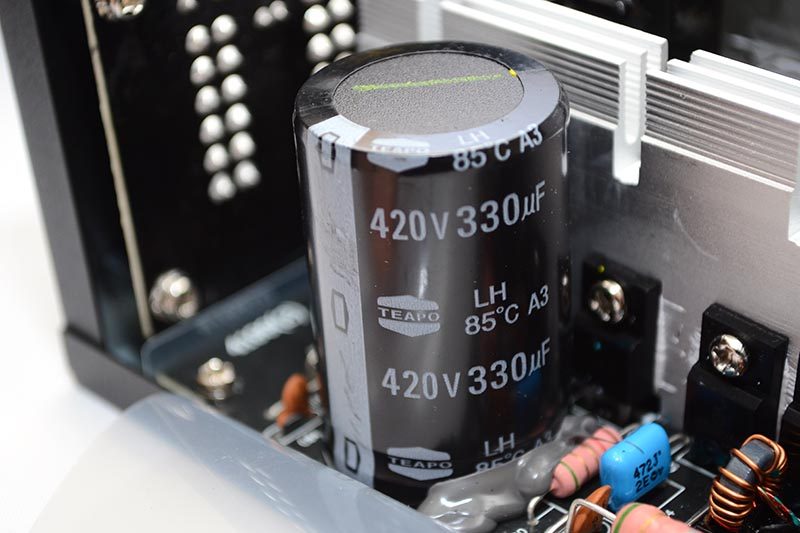
There’s a little tricky to see, but all the other small caps are Teapo hardware too, and the Taiwanese brand has been producing reliable capacitors for almost 40-years now, so I’m confident the Pure Power 10 will deliver some solid results today.
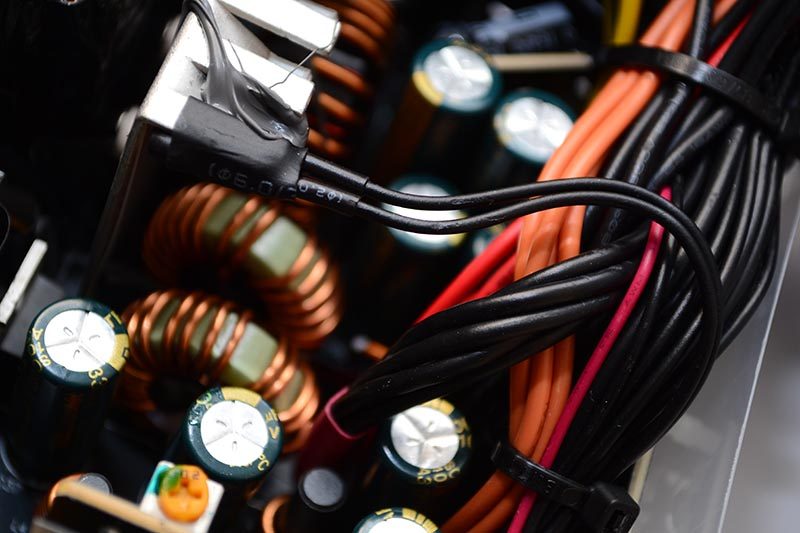
The cable management PCB looks nice and secure and comes with flawless soldering on all the connectors, which doesn’t sound like anything special, but most units we see do look a bit scruffy on at least one side, not the case here though.
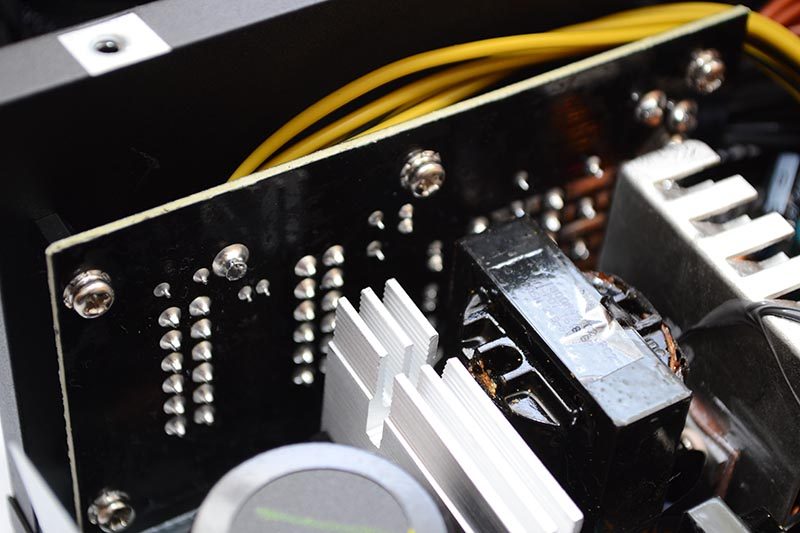
Since this is a semi-modular unit, there are some cables running into the unit and directly to the PCB, but they’re neatly bundled together with a tie, and off to the side so not to interrupt the airflow.
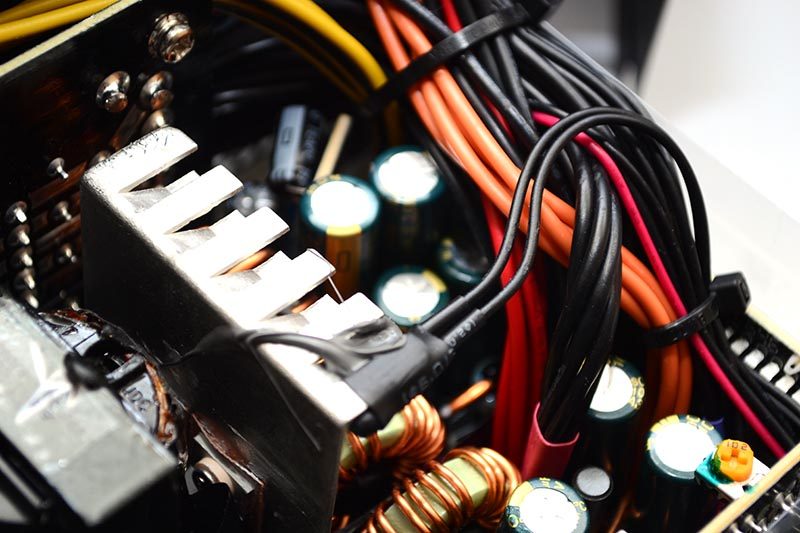
All cables that contact the PCB are fixed with good-looking soldering joints, and heat shrink wrapping on the top side, ensuring no cables short out any other cables.
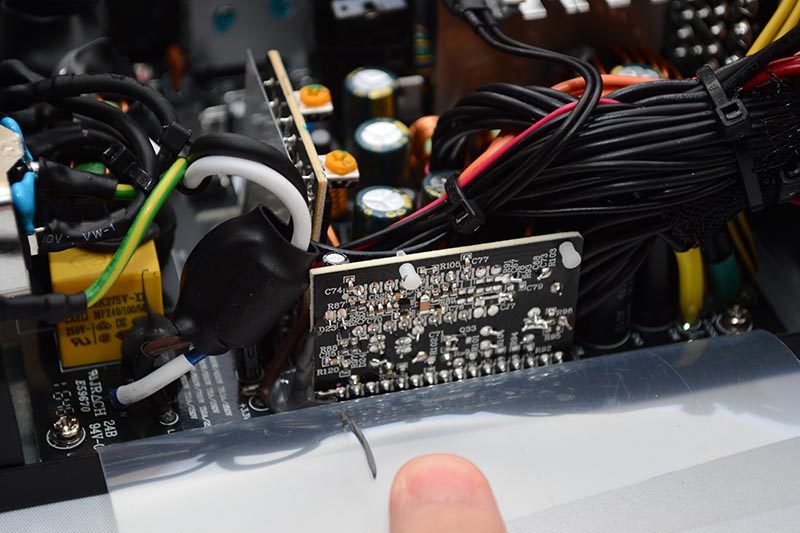
Finally, the fan comes with a seven-blade design, rifled fins to help reduce turbulence and improve airflow and is designed to operate at up to 1800RPM, although we doubt it’ll ever get that high unless you’re running it in an incredibly warm room for extended periods.
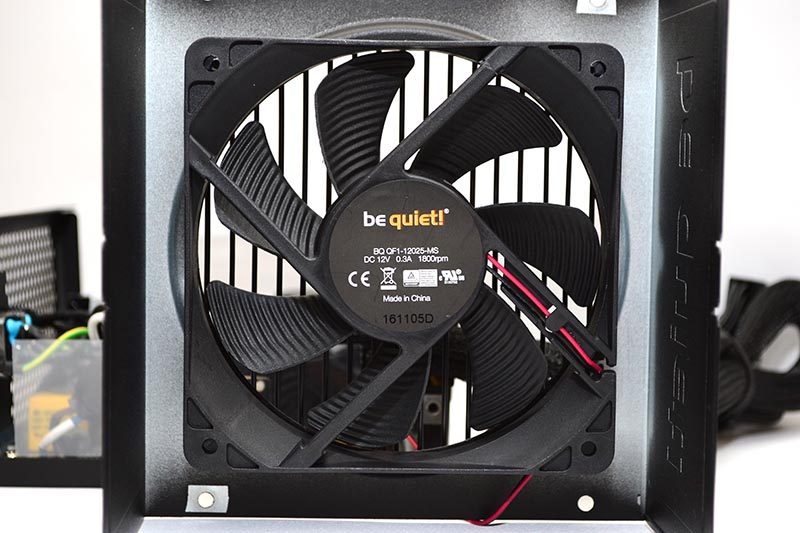
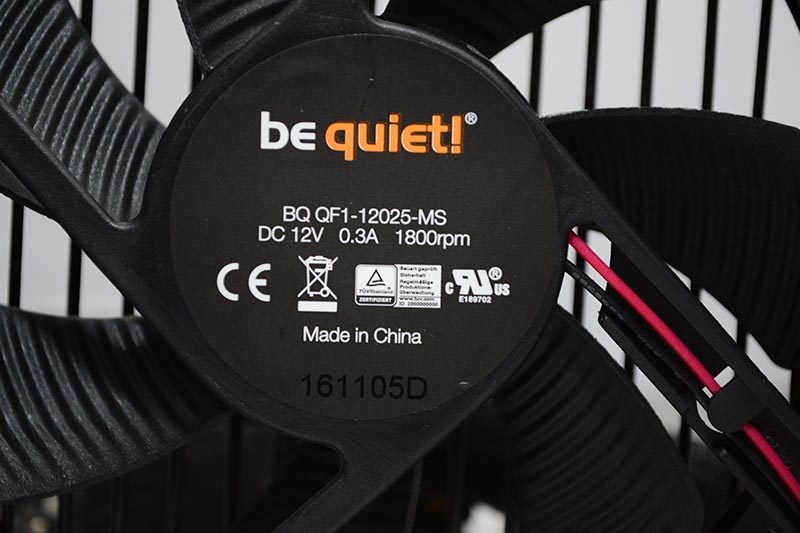
Test Procedure
At eTeknix we take the power supply testing procedure very seriously and have invested a lot of resources into acquiring the appropriate testing equipment. For all power supply reviews we test the power supplies with dedicated power supply testing equipment. This means we are able to get the most accurate results from our testing as opposed to using software benchmarks (such as OCCT) or multi-meter readouts which are broadly inaccurate.
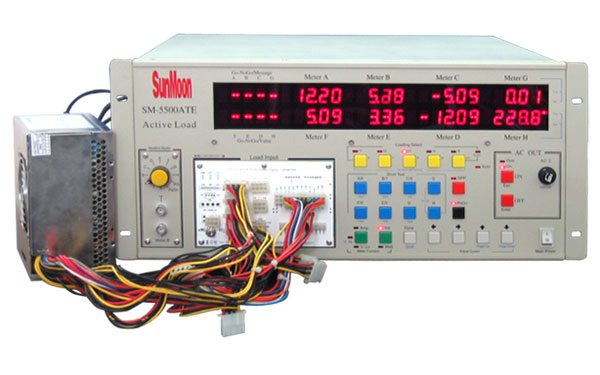
Our test machinery is as follows:
- Sunmoon SM-5500ATE Active Load Tester (1200W rated)
- Stingray DS1M12 USB Oscilloscope
- Voltcraft DT-10L laser tachometer
The eTeknix test procedure involves:
- Testing each power supply at 20/40/60/80/100% load (with balanced load across all rails) and measuring PFC (power factor correction), efficiency (actual power divided by power “pulled at the wall”) and voltage regulation (deviance from expected voltages of 3.3/5/12 on the main rails).
- Measuring ripple with an oscilloscope at 20/40/60/80/100% load.
- Measuring fan speed after a stabilisation period of five minutes at each load scenario using the Voltcraft DT-10L laser tachometer and a reflective strip on the fan.
- Testing each power supply’s OPP (Over Power Protection) mechanism and seeing how many watts each power supply can deliver before shutting down
Other things to consider are that
- We recognise that a single yellow 12 volt cable can provide only 6 Amps before overheating (which corrupts voltage regulation and efficiency) and so we used an adequate number of cables for each power supply to ensure there is not efficiency loss from poor cables selection
- Our Sunmoon SM-5500ATE power supply tester is not capable of testing more than 300W on each of the 12 volt rails so where a power supply provides more than 300W on a 12 volt rail that power is distributed over multiple 12 volt rails on the load tester. For example a power supply with one 12 volt rail supplying 750 watts would be spread equally over three 12 volt rails on the load tester, a power supply with two 450W 12v rails would be spread over four 12v rails on the load tester, two 225W 12v rails for each of the 12v rails on the unit.
- We use the same time scale and horizontal millivolt scale on our oscilloscope for all ripple tests, that is a 20ms T/DIV (horizontal) and a 0.02 V/DIV (vertical) meaning the scale is from -80mV to +80mV, ATX spec dictates that the 12v rail must fall within 150mv of ripple and the 3.3/5 within 50mv so that scale allows us to include both 150 and 50mV peaks. (Some older PSU reviews use different scales which were later ditched as the visual representation they give is inadequate, in these reviews written measurements are provided only).
- Deviance is the terminology used to represent the way voltages diverge from the expected values
Efficiency, PFC and Voltage Regulation
Voltage Regulation
To test voltage regulation we load the power supply to five different load scenarios that give an equal spread of load across every single rail. So that means 20% on all rails, 40% on all rails and so on. We then calculate the average deviance of each rail from its expected voltage.

Voltage regulation is pretty solid here, with only a small % droop on the 5V and 3.3V, but both are still within a comfortable range, especially between 40-80% load. The ones that really matter, such as the 12V rails are much better, giving pretty consistant results in general, but again drooping a little more at 20% and 100% load, but all far from being a problem.
Power Efficiency
Power efficiency is measured by calculating actual supplied wattage divided by the wattage drawn at the wall/plug, multiplied by 100 to give a percentage. We then compare that to the particular 80 Plus certification the company claims to see if it meets that. You can see the 80 Plus certifications below, we always test 230v power supplies.
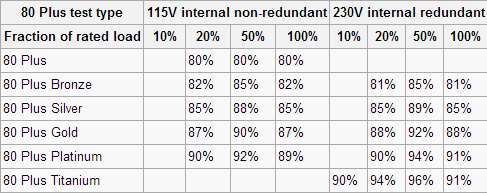
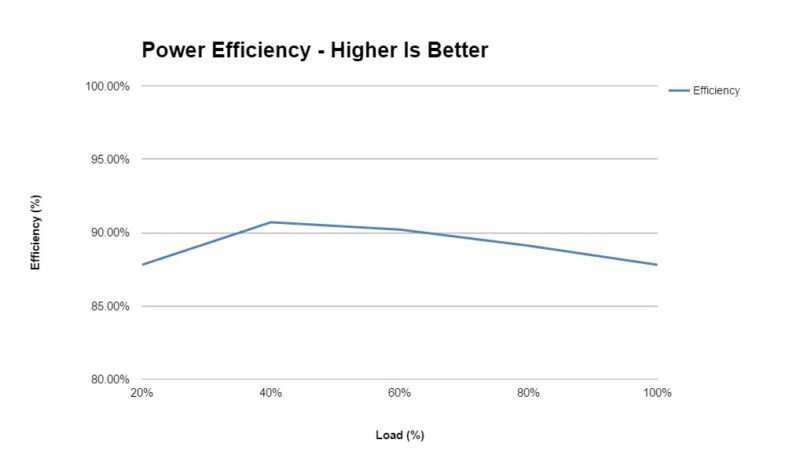
80 Plus Silver efficiency is certain a welcome bonus while buying a PSU, but the Pure Power 10 makes easy work of the Silver rating and is pushing into the territory of 80 Plus Gold, so that’s certainly excellent value for money.
Power Factor Correction
Power Factor Correction is the ratio of the real power flowing to the load, to the apparent power in the circuit. The aim of PFC is to make the load circuitry that is power factor corrected appear purely resistive (apparent power equal to real power). In this case, the voltage and current are in phase and the reactive power consumption is zero. The closer the number to one the better as this allows the most efficient delivery of electrical power (Source – Wikipedia).
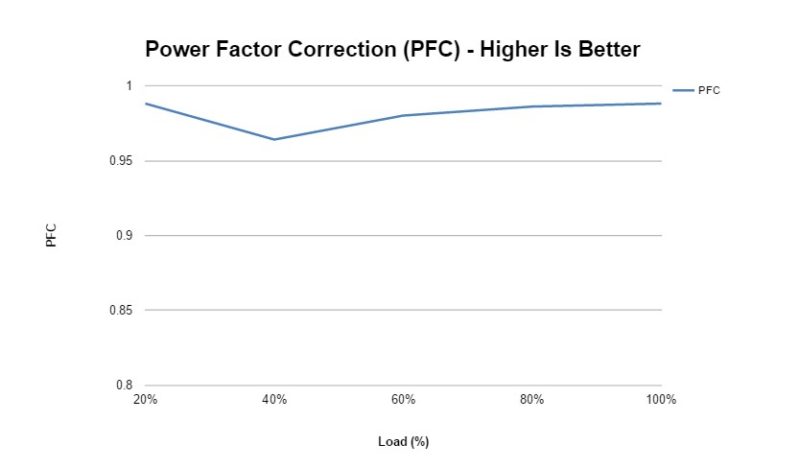
The closer to 1 the better when it comes to this score, and for what is basically a budget unit from be quiet! the Pure Power 10 does a fantastic job here, with fantastically reliable results.
Ripple
Noise and Ripple can easily be measured by an oscilloscope. These show how much voltage fluctuation there is on a particular rail. We tested the rail stability of the 3.3 volt, 5 volt and 12 volt rails using an identical time and millivolt scale for all graphs. millivolt ripple is measured by the peak to peak size of the voltage curve.
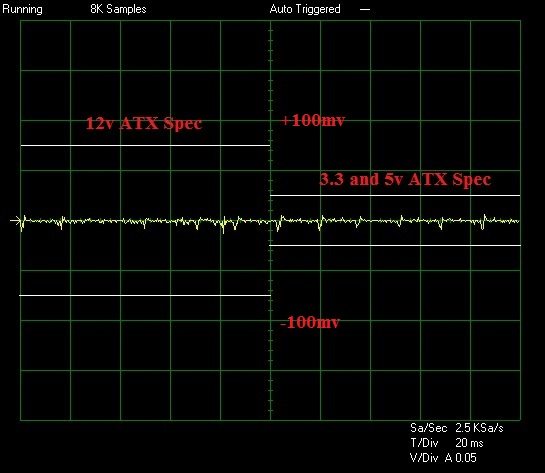
Sample Ripple Graph
The latest ATX 12 volt version 2.3 specifications state that ripple from peak to peak must be no higher than 50 millivolts for the 3.3 volt and 5 volt rails, while the 12 volt rail is allowed up to 120 millivolts peak to peak to stay within specifications. Millivolt figures are stated to the closest increment of 5 given their variability.
| Load (%) | 3.3V Ripple | 5V Ripple | 12V Ripple |
| 20 | 8.2 | 6.8 | 7.4 |
| 40 | 12 | 8.8 | 7.6 |
| 60 | 15.2 | 10.4 | 9.6 |
| 80 | 20 | 13.6 | 13 |
| 100 | 24 | 15.2 | 17 |
Another impressive result, with low ripple across all rails, meaning nice and clean power delivery that won’t throw up any issues.
3.3 volt @ 100%
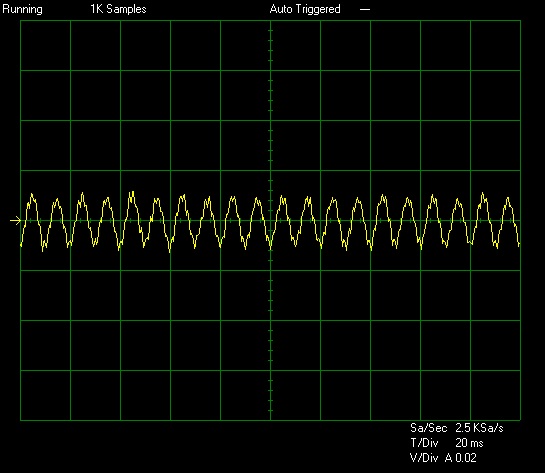
5 volt @ 100%
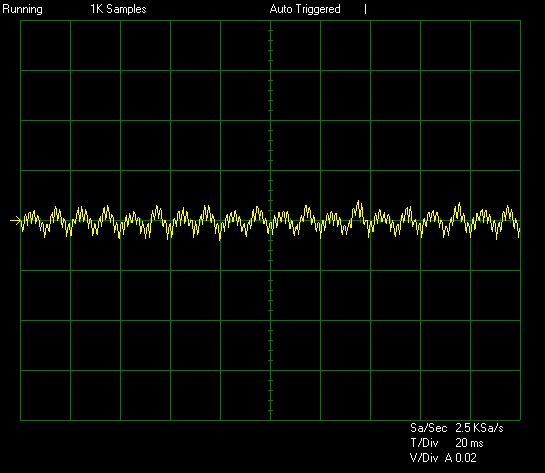
12 volt @ 100%
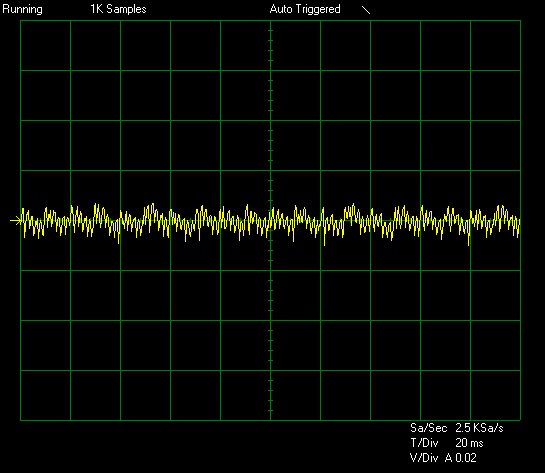
Over Power Protection and Max Wattage
Power supplies often quote as having various protection mechanisms such and the most important of these is Over Power Protection. In our testing we crank up the power draw until the power supply either shuts down (meaning the OPP mechanism is present and working) or blows up (meaning it is either not present or not working). We then note the maximum power consumption before the power supply shut down (or blew up).

The use of quality capacitors is clear here, with the 600W unit able to draw 674W before the OPP kicked in and shut it down. At more than 10% over the official rating, this is impressive, so there shouldn’t be any concern about power draw spikes from your components.
Fan Speed
When testing in a power supply laboratory it is difficult to take fan noise readings as the noise from the Sunmoon test equipment and air conditioning corrupts everything. The next best thing in our circumstances was reading off the fan speed with a tachometer to get an idea for the noise. The ambient temperature during testing held constant at 22 degrees, with 1 degree of variation. Each power supply had a consistent time period of 5 minutes to stabilise between each load scenario.
In my experience the following general relationships apply between noise levels and fan speeds, though it can vary greatly between the type of fan used.
- Below 800 RPM – Inaudible/Silent
- 800 to 1000 RPM – Barely audible
- 1000 – 1200 RPM – Audible but still quiet
- 1200 – 1400 RPM – Moderately noisy
- 1400 – 1800 RPM – Noisy
- 1800 RPM or higher – Intolerable
While it looks like the fan speed was all over the place here, it really only ran between 538 and 555RPM, which is pretty darn slow and was virtually silent. We did report that the fan can operate up to 1800RPM, but I imagine it would have to pretty much be in a burning building before it needed to work that hard to cool the PSU.
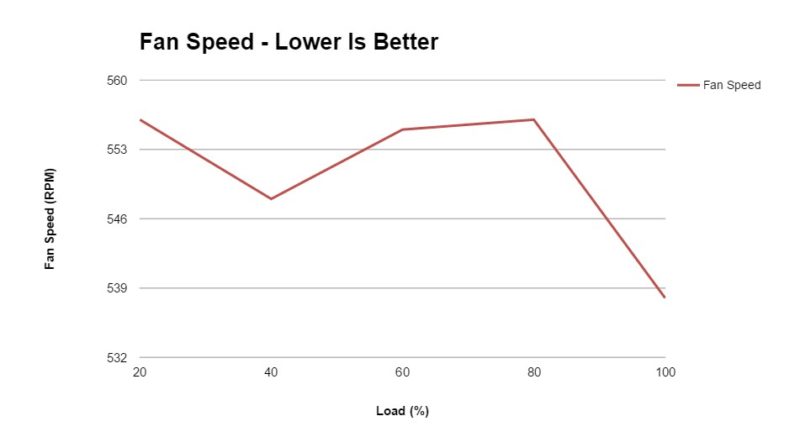
Final Thoughts
Pricing
The be quiet! Pure Power 10 600W launches today and should be available at major retailers pretty quickly. be quiet! forwarded us the following MSRP information, but expect a little fluctuation and competition in prices from retailer to retailer.
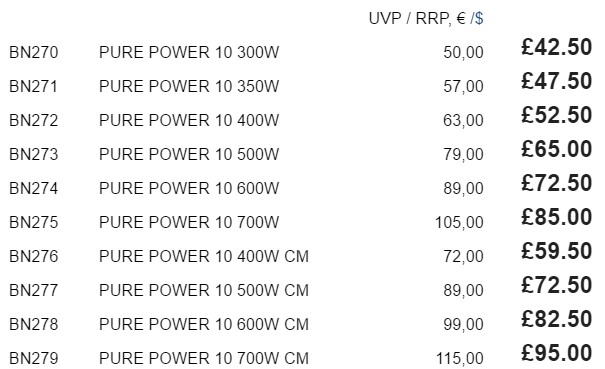
Conclusion
be quiet! is one of the most trusted names in the business when it comes to desktop power supplies, and we’re happy to see they’re holding onto that reputation with the Pure Power 10. This isn’t their best unit, that’s an honour still held by their fantastic Dark Power Pro series, but they’re much more expensive than Dark Power units.
The build quality is fantastic on this unit, and it has a clean interior design, good quality capacitors, durable cables, and best of all that lovely be quiet! fan. They may be pushing for a more affordable price here, but it doesn’t look like they cut back on attention to details. Speaking of that fan, the fact it barely got close to 600RPM is impressive, and you’ll never hear the fan spin at those speeds, it practically silent.
The modular cables are a nice bonus, and while I would have liked flat cables on the semi-modular wires, it’s hardly a deal breaker at these prices. The cables are easy to use and come with durable connectors, so adjusting them to suit your build is pretty straight forward.
The power delivery on this unit is pretty good, with only a few very minor falters, but still as good or better than most in this price and wattage range. There’s a little voltage droop at 100%, but if you’re planning on maxing out a 600W unit for a long time, perhaps it would be wise to invest in a bigger output unit anyway.
Overall, the Pure Power 10 is a blend of great build quality, stylish design, whisper quiet performance, and competitive prices, making it a fantastic choice for any system builder.
Pros
- Stylish aesthetics
- Durable build quality
- Extremely quiet fan
- Semi-modular design
- Flat modular cables
- Excellent efficiency
- Trusted brand
- Great price
Cons
- None
Neutral
- Slight voltage droop at 100% load
“If you’re looking for a reliable power supply for a mid-to-high-end system, the be quiet! Pure Power 10 is a fantastic balance of quality and price.”

be quiet! Pure Power 10 600W Power Supply Review
